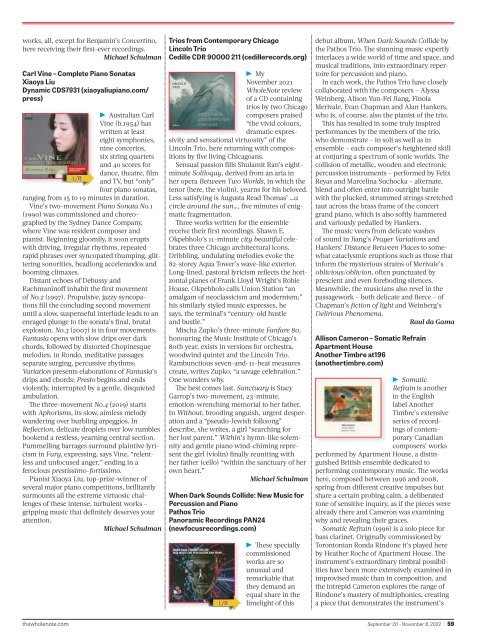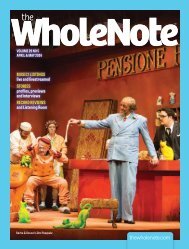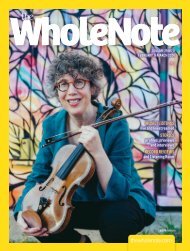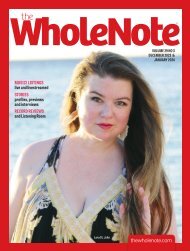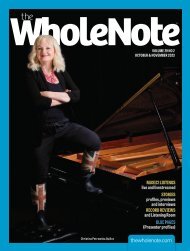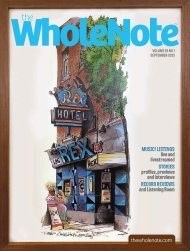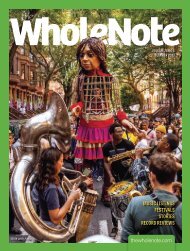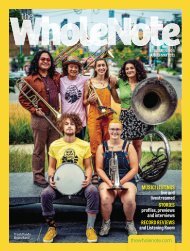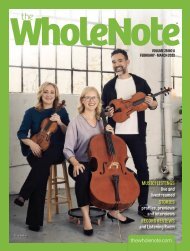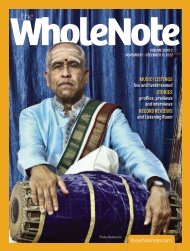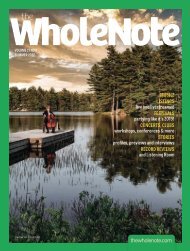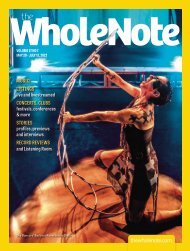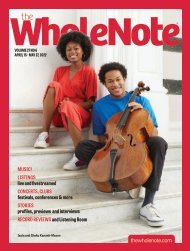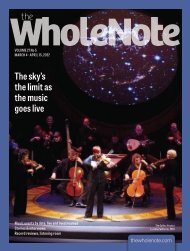Volume 28 Issue 1 | September 20 - November 8, 2022
Our 28th season in print! “And Now, Back to Live Action”; a symphonic-sized listings section, compared to last season; clubs “On the move” ; FuturesStops Festival and Nuit Blanche; “Pianistic high-wire acts”; Season announcements include full-sized choral works like Mendelssohn’s Elijah; “Icons, innovators and renegades” pulling out all the stops.
Our 28th season in print! “And Now, Back to Live Action”; a symphonic-sized listings section, compared to last season; clubs “On the move” ; FuturesStops Festival and Nuit Blanche; “Pianistic high-wire acts”; Season announcements include full-sized choral works like Mendelssohn’s Elijah; “Icons, innovators and renegades” pulling out all the stops.
Create successful ePaper yourself
Turn your PDF publications into a flip-book with our unique Google optimized e-Paper software.
works, all, except for Benjamin’s Concertino,<br />
here receiving their first-ever recordings.<br />
Michael Schulman<br />
Carl Vine – Complete Piano Sonatas<br />
Xiaoya Liu<br />
Dynamic CDS7931 (xiaoyaliupiano.com/<br />
press)<br />
! Australian Carl<br />
Vine (b.1954) has<br />
written at least<br />
eight symphonies,<br />
nine concertos,<br />
six string quartets<br />
and 40 scores for<br />
dance, theatre, film<br />
and TV, but “only”<br />
four piano sonatas,<br />
ranging from 15 to 19 minutes in duration.<br />
Vine’s two-movement Piano Sonata No.1<br />
(1990) was commissioned and choreographed<br />
by the Sydney Dance Company,<br />
where Vine was resident composer and<br />
pianist. Beginning gloomily, it soon erupts<br />
with driving, irregular rhythms, repeated<br />
rapid phrases over syncopated thumping, glittering<br />
sonorities, headlong accelerandos and<br />
booming climaxes.<br />
Distant echoes of Debussy and<br />
Rachmaninoff inhabit the first movement<br />
of No.2 (1997). Propulsive, jazzy syncopations<br />
fill the concluding second movement<br />
until a slow, suspenseful interlude leads to an<br />
enraged plunge to the sonata’s final, brutal<br />
explosion. No.3 (<strong>20</strong>07) is in four movements:<br />
Fantasia opens with slow drips over dark<br />
chords, followed by distorted Chopinesque<br />
melodies; in Rondo, meditative passages<br />
separate surging, percussive rhythms;<br />
Variation presents elaborations of Fantasia’s<br />
drips and chords; Presto begins and ends<br />
violently, interrupted by a gentle, disquieted<br />
ambulation.<br />
The three-movement No.4 (<strong>20</strong>19) starts<br />
with Aphorisms, its slow, aimless melody<br />
wandering over burbling arpeggios. In<br />
Reflection, delicate droplets over low rumbles<br />
bookend a restless, yearning central section.<br />
Pummelling barrages surround plaintive lyricism<br />
in Fury, expressing, says Vine, “relentless<br />
and unfocused anger,” ending in a<br />
ferocious prestissimo-fortissimo.<br />
Pianist Xiaoya Liu, top-prize-winner of<br />
several major piano competitions, brilliantly<br />
surmounts all the extreme virtuosic challenges<br />
of these intense, turbulent works –<br />
gripping music that definitely deserves your<br />
attention.<br />
Michael Schulman<br />
Trios from Contemporary Chicago<br />
Lincoln Trio<br />
Cedille CDR 90000 211 (cedillerecords.org)<br />
! My<br />
<strong>November</strong> <strong>20</strong>21<br />
WholeNote review<br />
of a CD containing<br />
trios by two Chicago<br />
composers praised<br />
“the vivid colours,<br />
dramatic expressivity<br />
and sensational virtuosity” of the<br />
Lincoln Trio, here returning with compositions<br />
by five living Chicagoans.<br />
Sensual passion fills Shulamit Ran’s eightminute<br />
Soliloquy, derived from an aria in<br />
her opera Between Two Worlds, in which the<br />
tenor (here, the violin), yearns for his beloved.<br />
Less satisfying is Augusta Read Thomas’ …a<br />
circle around the sun…, five minutes of enigmatic<br />
fragmentation.<br />
Three works written for the ensemble<br />
receive their first recordings. Shawn E.<br />
Okpebholo’s 11-minute city beautiful celebrates<br />
three Chicago architectural icons.<br />
Dribbling, undulating melodies evoke the<br />
82-storey Aqua Tower’s wave-like exterior.<br />
Long-lined, pastoral lyricism reflects the horizontal<br />
planes of Frank Lloyd Wright’s Robie<br />
House. Okpebholo calls Union Station “an<br />
amalgam of neoclassicism and modernism;”<br />
his similarly styled music expresses, he<br />
says, the terminal’s “century-old hustle<br />
and bustle.”<br />
Mischa Zupko’s three-minute Fanfare 80,<br />
honouring the Music Institute of Chicago’s<br />
80th year, exists in versions for orchestra,<br />
woodwind quintet and the Lincoln Trio.<br />
Rambunctious seven-and-11-beat measures<br />
create, writes Zupko, “a savage celebration.”<br />
One wonders why.<br />
The best comes last. Sanctuary is Stacy<br />
Garrop’s two-movement, 23-minute,<br />
emotion-wrenching memorial to her father.<br />
In Without, brooding anguish, urgent desperation<br />
and a “pseudo-Jewish folksong”<br />
describe, she writes, a girl “searching for<br />
her lost parent.” Within’s hymn-like solemnity<br />
and gentle piano wind-chiming represent<br />
the girl (violin) finally reuniting with<br />
her father (cello) “within the sanctuary of her<br />
own heart.”<br />
Michael Schulman<br />
When Dark Sounds Collide: New Music for<br />
Percussion and Piano<br />
Pathos Trio<br />
Panoramic Recordings PAN24<br />
(newfocusrecordings.com)<br />
! These specially<br />
commissioned<br />
works are so<br />
unusual and<br />
remarkable that<br />
they demand an<br />
equal share in the<br />
limelight of this<br />
debut album, When Dark Sounds Collide by<br />
the Pathos Trio. The stunning music expertly<br />
interlaces a wide world of time and space, and<br />
musical traditions, into extraordinary repertoire<br />
for percussion and piano.<br />
In each work, the Pathos Trio have closely<br />
collaborated with the composers – Alyssa<br />
Weinberg, Alison Yun-Fei Jiang, Finola<br />
Merivale, Evan Chapman and Alan Hankers,<br />
who is, of course, also the pianist of the trio.<br />
This has resulted in some truly inspired<br />
performances by the members of the trio,<br />
who demonstrate – in soli as well as in<br />
ensemble – each composer’s heightened skill<br />
at conjuring a spectrum of sonic worlds. The<br />
collision of metallic, wooden and electronic<br />
percussion instruments – performed by Felix<br />
Reyas and Marcelina Suchocka – alternate,<br />
blend and often enter into outright battle<br />
with the plucked, strummed strings stretched<br />
taut across the brass frame of the concert<br />
grand piano, which is also softly hammered<br />
and variously pedalled by Hankers.<br />
The music veers from delicate washes<br />
of sound in Jiang’s Prayer Variations and<br />
Hankers’ Distance Between Places to somewhat<br />
cataclysmic eruptions such as those that<br />
inform the mysterious strains of Merivale’s<br />
oblivious/oblivion, often punctuated by<br />
prescient and even foreboding silences.<br />
Meanwhile, the musicians also revel in the<br />
passagework – both delicate and fierce – of<br />
Chapman’s fiction of light and Weinberg’s<br />
Delirious Phenomena.<br />
Raul da Gama<br />
Allison Cameron – Somatic Refrain<br />
Apartment House<br />
Another Timbre at196<br />
(anothertimbre.com)<br />
! Somatic<br />
Refrain is another<br />
in the English<br />
label Another<br />
Timbre’s extensive<br />
series of recordings<br />
of contemporary<br />
Canadian<br />
composers’ works<br />
performed by Apartment House, a distinguished<br />
British ensemble dedicated to<br />
performing contemporary music. The works<br />
here, composed between 1996 and <strong>20</strong>08,<br />
spring from different creative impulses but<br />
share a certain probing calm, a deliberated<br />
tone of sensitive inquiry, as if the pieces were<br />
already there and Cameron was examining<br />
why and revealing their graces.<br />
Somatic Refrain (1996) is a solo piece for<br />
bass clarinet. Originally commissioned by<br />
Torontonian Ronda Rindone it’s played here<br />
by Heather Roche of Apartment House. The<br />
instrument’s extraordinary timbral possibilities<br />
have been more extensively examined in<br />
improvised music than in composition, and<br />
the intrepid Cameron explores the range of<br />
Rindone’s mastery of multiphonics, creating<br />
a piece that demonstrates the instrument’s<br />
thewholenote.com <strong>September</strong> <strong>20</strong> - <strong>November</strong> 8, <strong>20</strong>22 | 59


